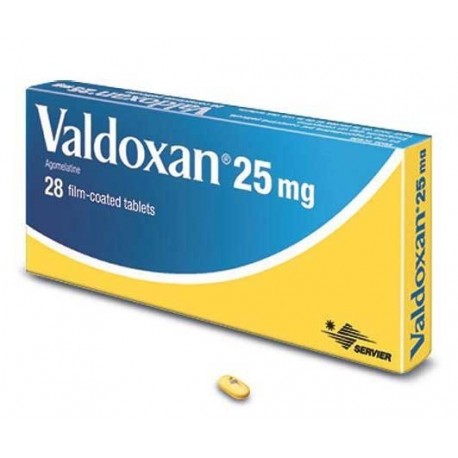Volume discounts
| Quantity | Discount | You Save |
|---|---|---|
| 2 | 5% | Up to $4.60 |
| 3 | 10% | Up to $13.80 |
| 4 | 15% | Up to $27.60 |
| 5 | 20% | Up to $46.00 |
More info
VALDOXAN 25 mg film-coated tablets
It is taken by mouth.
Active ingredient
25 mg Agomelatine.
Excipients
Corn starch, povidone, sodium starch glycolate, stearic acid, magnesium stearate, silica colloidal anhydrate, lactose monohydrate, hypromellose, glycerol, macrogol 6000, yellow iron oxide (E172) and titanium dioxide (E171). Blue printing ink: contains propylene glycol and indigotine (E132) aluminum lacquer.
What is Valdoxan and what is it used for?
VALDOXAN film-coated tablet, orange-yellow, rod-shaped (9.5 mm long and 5.1 mm wide) with blue imprint on one side.
Each VALDOXAN film-coated tablets contain 25 mg of agomelatine.
VALDOXAN film-coated tablets are available in calendared blister packs of 28 tablets.
Valdoxan belongs to the group of drugs used in the treatment of depression (other antidepressants) and has been prescribed for your depression treatment.
Depression is a persistent mood disorder that negatively affects daily life. Depression symptoms vary from one person to another. However, common symptoms include loss of interest and pleasure, depressed mood, loss of energy, sleep, appetite and sexual problems, feelings of worthlessness, unwarranted regret and guilt, pessimism, helplessness, and attention problems.
3.How to use VALDOXAN?
• The recommended dose of Valdoxan is one tablet (25 mg) before going to bed. In some cases, the dose may be increased to two tablets (50 mg) at bedtime when prescribed by your doctor.
Valdoxan begins to show its effect in most depressed patients from the second week of treatment. Even if you feel well, your doctor will recommend that you continue treatment with Valdoxan so that the symptoms of depression do not recur.
Depression should be treated for at least 6 months to relieve symptoms.
Even if you feel well, do not stop using your medication without consulting your doctor.
How should I stop using an antidepressant drug and switch to Valdoxan?
If your doctor wants to switch from a previous SSRESNRI antidepressant (sertraline, escitalopram, fluoxetine, venlafaxine or duloxetine) to Valdoxan, he will advise you on how to discontinue your previous treatment when starting Valdoxan.
Even if you gradually reduce the antidepressant medication you used before, you may experience withdrawal symptoms due to stopping the medication for a few weeks.
These symptoms are: dizziness, tingling, sleep disturbance, restlessness or anxiety, headache, feeling sick, and tremors. These effects are usually mild to moderate and disappear spontaneously within a few days.
Possible discontinuation symptoms that may occur if Valdoxan is started while the dose of the previous treatment is reduced should not suggest that the early effect of Valdoxan is insufficient.
When starting Valdoxan, you should discuss the best way to stop previous antidepressant treatment with your doctor.
Application route and method
VALDOXAN is for oral use.
Swallow the tablets with a sufficient amount of water without chewing.
VALDOXAN can be taken with food or alone.
Alcohol should not be taken while being treated with Valdoxan.
Different age groups
Use in children
As the efficacy and safety of Valdoxant has not been studied in these patient groups, it is not used in children and adolescents (under 18 years of age).
Use in the elderly
The effect of VALDOXAN has not been documented in patients 75 years of age or older. Therefore, Valdoxan should not be used in patients in this age group.
Special use cases
Kidney failure:
It will be determined whether you can safely use VALDOXAN as a result of the individual evaluation by your doctor in patients with renal insufficiency.
Liver failure (see section 2):
Your doctor will do laboratory tests to check that your liver is working properly before starting treatment and during the 3rd, 6th, 12th, and 24th weeks. If your doctor increases the dose of the drug to 50 mg, these tests should be performed again at the beginning and during the 3rd, 6th, 12th and 24th weeks during the treatment. The tests will then continue if your doctor needs it.
Do not use VALDOXAN if you have liver failure.
If you have the impression that the effect of VALDOXAN is too strong or too weak, talk to your doctor or pharmacist.
If you use more VALDOXAN than you should
Cases of overdose with Valdoxan are limited, pain, drowsiness, fatigue, agitation (overflow / restlessness) in the upper abdomen, anxiety, tension, dizziness, cyanosis (bruising) and malaise have been reported.
If you have used VALDOXAN more than you should, talk to a doctor or pharmacist.
If you forgot to use VALDOXAN
Do not take a double dose to make up for forgotten doses. Continue taking the next dose at your usual time. The calendar printed on the blister containing the tablets will remind you when you last took the VALDOXAN tablet.


